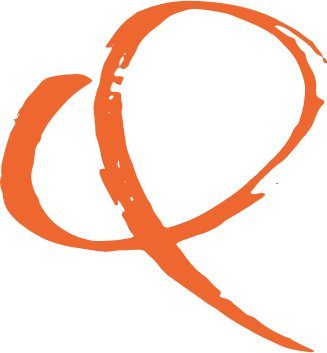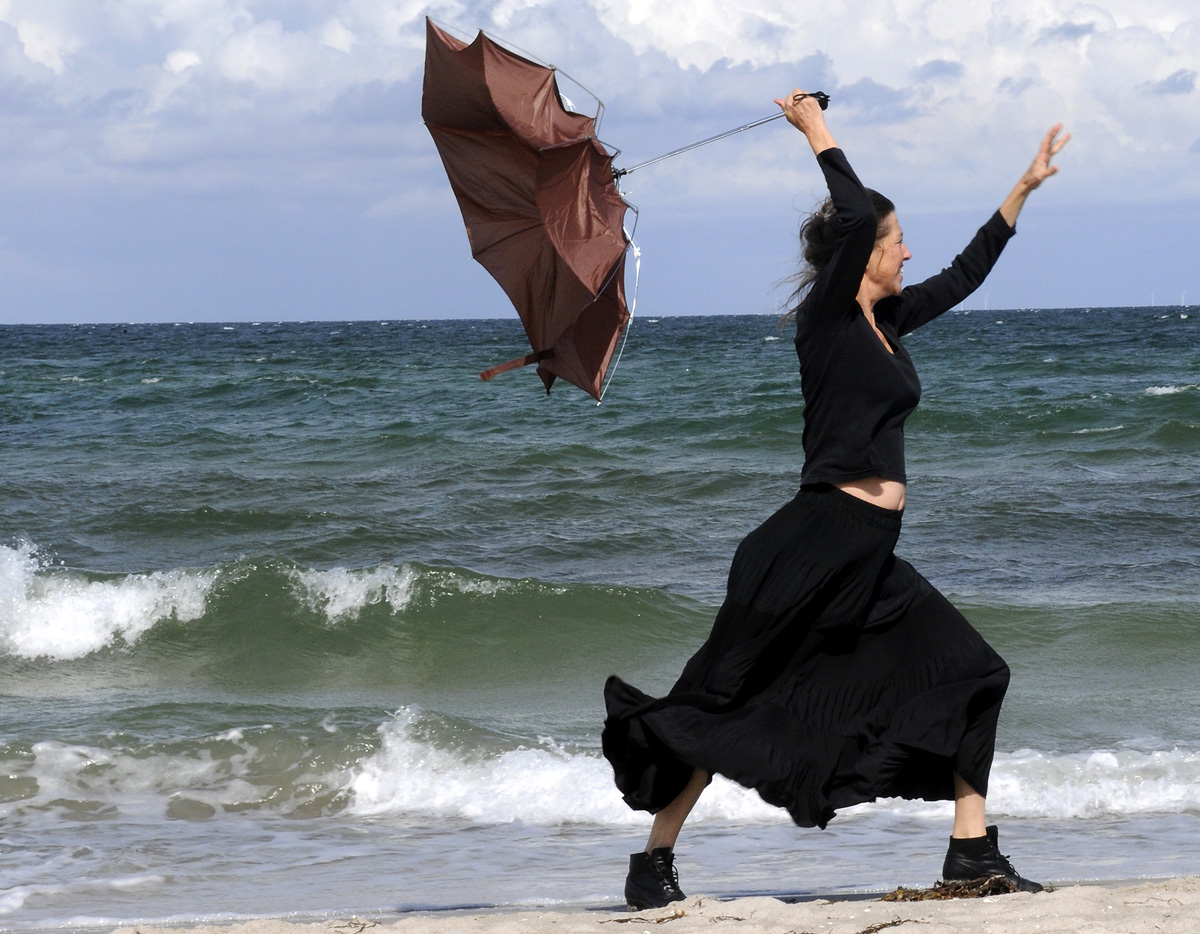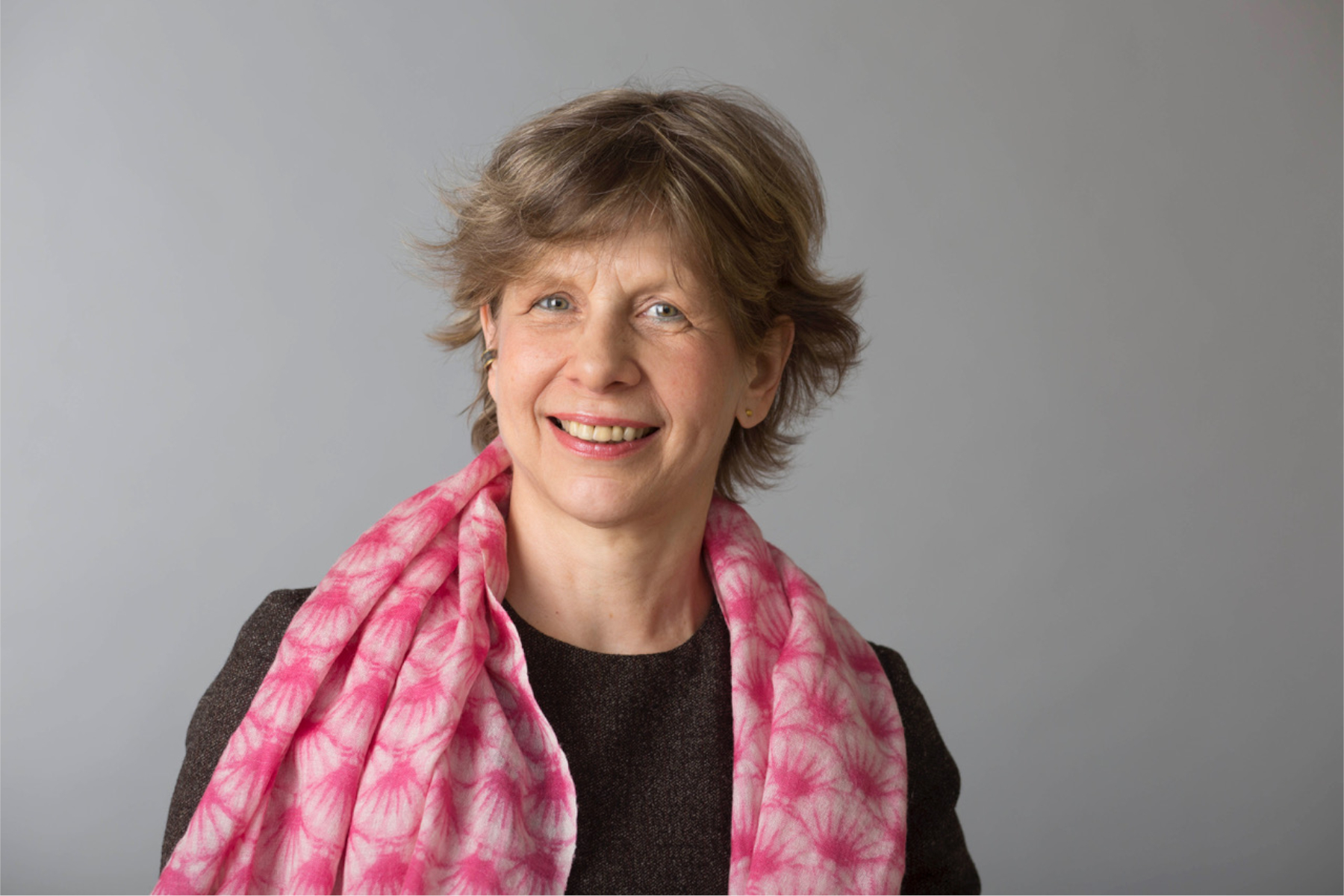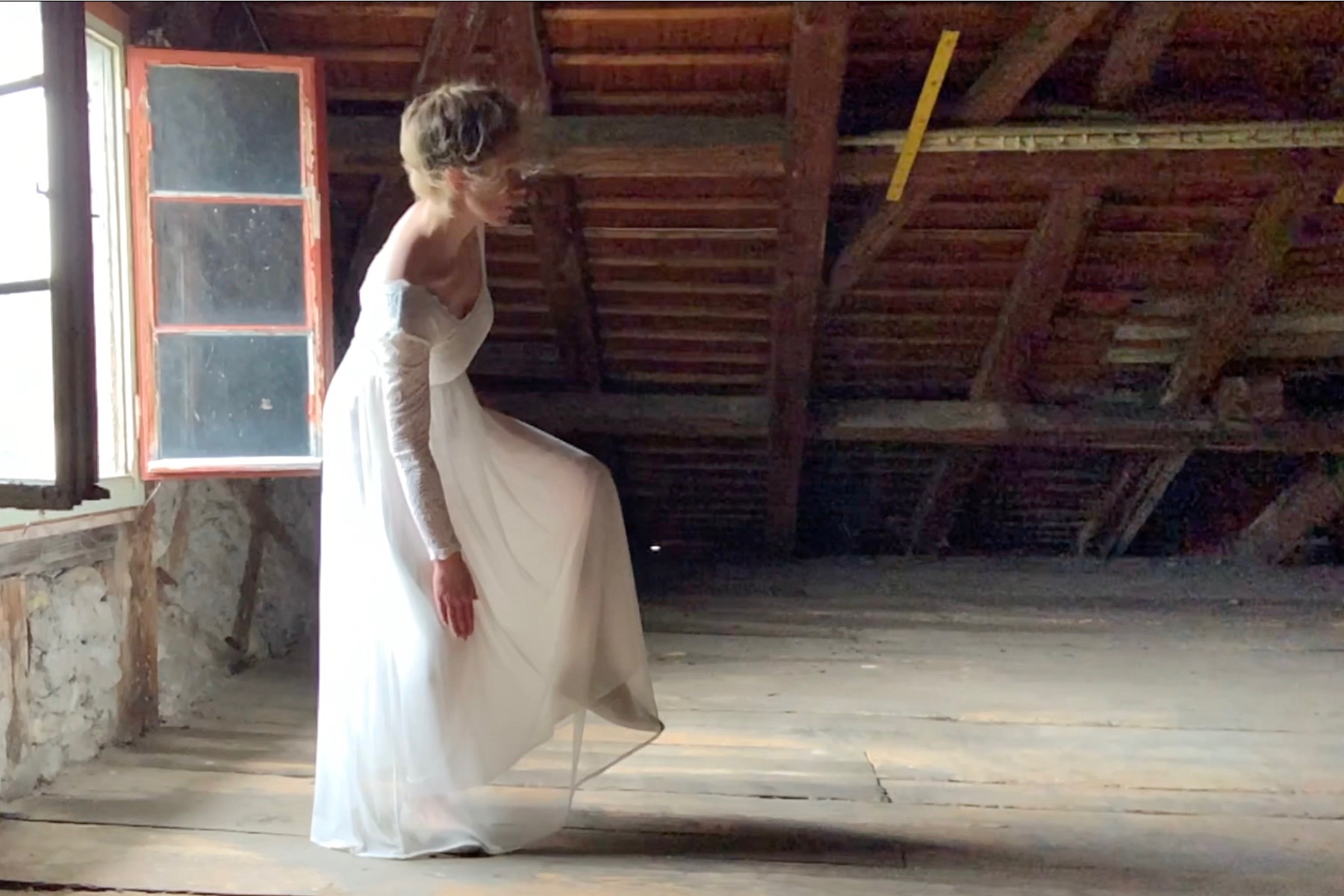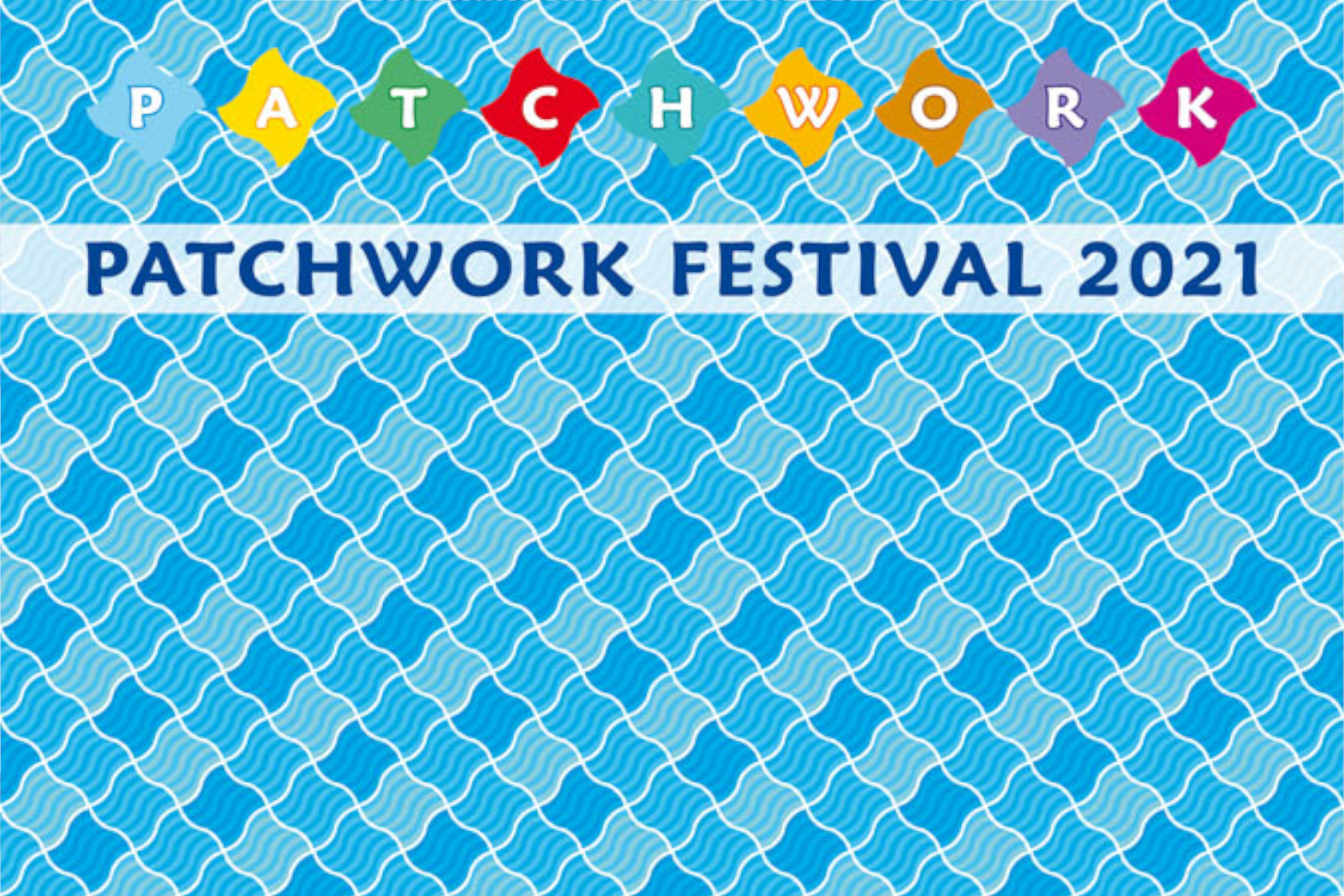The MIMAGES Festival is organized by the international Quo Vadis agency initiated in 2016 by Ernst Reepmaker with the aim to create an international infrastructure for presenting and programming professional Eurythmy art. The festival is a novelty within the current landscape of Eurythmy, offering the audience the possibility to experience and encounter a broad spectrum of styles and themes that live in contemporary expressions of the art of Eurythmy. Each day opens with an early morning encounter between art works in the galleries of the Pulchri Studio and performers who are invited to engage with the art works from the various perspectives of their individual eurythmic interpretations. The programme then continues at the Anthroposophical center of the Elisabeth Vreedehuis where performers from the Netherlands, Germany, Austria, USA, Brazil and Spain contribute to an artistic encounter in the form of workshops, discussions and artistic intermezzos between local and international artists who develop their work in relation to the art of Eurythmy and inspired by the Anthroposophical spirit.
PULCHRI STUDIO 27.9.2019
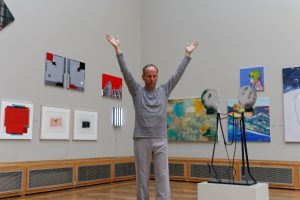
On 27. September, the first dialogue between a contemporary interpretation of Eurythmy and the art works at the Pulchri studio is presented by Alexander Seeger, Professor of Eurythmy at the Alanus University of Arts and Social Sciences in Alfter, Germany. Alexander begins to speak about the crossing of a border, the threshold between being embodied in a human body, the leaving of the physical body and the experience of non physical contact with an individual, a friend, who has passed this threshold and who is invited to be present with him, the artworks and the audience during the performance. The tone is set – the performance is situated at the threshold between the personal and the universal, the physical and the metaphysical. In dialogue with pianist Victor Moser and Liszt’s Petrarch Sonnet 104, Alexander Seeger continues to iterate between speaking to the audience about his personal experience with this threshold and a refined and deeply focused eurythmic interpretation of Liszt’s composition. Inner movement appears to be given priority as well as a serene and laser sharp ability to control the inner movement in its resonance and spatial expression with fast displacements of the body through space during the intensified sequences of the musical composition. Most expressive are the movement of his arms and his choices of swift changes of direction in space, carried by precise footwork. The overall impression of his Eurythmic art appears to be grounded in a deep knowledge of its original guiding principles yet seeking to give it a contemporary feel, a future orientation. Seeger chooses as a point of reference in the Pulchri Studio the redness that seems to radiate even more strongly from one of the artworks, as if activated by his intention to engage with it. For Seeger, the color red delivers encouragement and trust when being confronted with and thematizing the transition from one dimension of reality into another. In dialogue with the sounds of Liszt’s composition, Seeger continues to speak about the third eye as a gateway to the above, giving the ability to sense beyond the physically sensible, to prevision and to intuit a paradisiacal beauty and youthfulness breaking through the materiality of the physical body. He is guiding the ear of the audience to find these healing and hopeful qualities inside 2 of their experience of the music and his eurythmic interpretation. Seeger then speaks also about the need to give up the struggle and revolt that accompanies threshold experiences and to surrender to the process, to be able to perceive and receive the joy and salvation of reuniting with forces of which we do not know where they come from or where they lead.
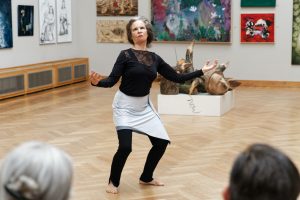
The second artist performing during this morning at the Pulchri gallery is Gail Langstroth, a poet, eurythmist and visual artist from Pittsburgh. “It has taken a whole lifetime to come here…” are the beginning words we hear from her when she enters the space and positions herself in the direction of a pile of objects that are tagged with the inscription NOW. Gail is a powerful performer, convinced and convincing, speaking with her whole being, uprooting each spoken word from the depths of her body in motion. She choses to place her eurythmic invention in relation to three artworks: a sculpture of a skeptically looking baby in a bucket of water together with a plastic duck titled “the beginning”, the NOW pile of objects and an artistic rendering of a photograph of a snake in the desert. With a good dose of humor but also with deeply engaged anger, she interweaves a poem written for a victim of gun violence with her physical poetry situated in the NOW of the Pulchri studio on 27. September 2019. Activating an acute awareness of severe injustice, Langstroth eventually inverts the NOW into a WON, claiming a victory of a personal life story over an inflicted space- and breathlessness through violence and oppression through a choice of retreating from society and reinventing a life in the deep jungle.
Gail Langstroth accompanies her performance with a personal account about her life path until NOW and about how she lived with the artworks for many hours before engaging with them through her art. She speaks about her experience at a priest seminary where she learned to “pull back her horses”, where she put reins on her desire to move and entered the art of listening instead by sitting on benches. The eurythmic process became an internal one, she became an ear. After the priest training she did a Master study in poetry and is now working with language as a whole body experience.
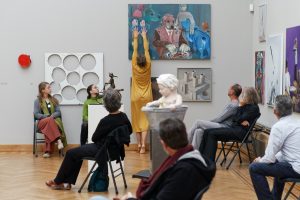
The third performer of this morning at the Pulchri studio is Juliette van Lelieveld (Euritmie Atelier). Her approach to the performance is based on allowing “the ultimate not knowing” to be the guiding principle. She intentionally did not prepare a plan for the performance and thus organically continues the emphasis on the NOW that has already been highlighted by Gail’s performance. Her performative presence is sparkling and very creative, it is obvious that she has cultivated in herself a reliance on an ever present inner guidance that prompts her creative activities. Her voice participates, expressing sounds and letters. She travels through the space visiting the art works as well as audience members and engages with their auras, or the energetic space surrounding their bodies, in a pleasant, slightly humorous, but sincere way. Her quality of performativity is characterized by immediacy, it is playful and uninhibited, anchored in a solid trust in her inner source of inspiration. Her presence is spacious. With her movements through the space in dialogue with the art works and the audience, she creates a dynamic sense of rhythm and perspective. She literally opens spaces, guiding the perception of the audience also towards the ceiling and the space beyond the space of the Pulchri Studio.
From a phenomenological point of view, it is interesting to observe how the artworks at the Pulchri Studio gradually come to life through the intentional engagement with them by the performers. They seemingly begin to radiate more, to speak more in their own terms. The aura of the artworks literally seems to become more tangible, although it is not easy to pinpoint by which kind of senses this perception comes to be. It might have to do with the conscious working with the auric, with the etheric, a zone of subtle materiality in between the non-physical and the physical which is characteristic of eurythmic work. From the Pulchri Studio we are now traveling to the Elisabeth Vreedehuis for a mini symposium and for workshops and performances.
ELISABETH VREEDEHUIS – MINI SYMPOSIUM 27.9.2019
Moderated by Ernst Reepmaker, participants of the mini symposium gather on the stage of the Euritmiezaal, accompanied by the audience members to open the coming days with a dialogical encounter on Eurythmy from different perspectives.
Ernst Reepmaker opens the dialogue by inviting the participants of the symposium to briefly introduce themselves, and to give an account about which motifs guide their relation to stage Eurythmy today – to speak about their visions, personal impressions and intuitions. This in order to provide a palette of different perspectives on cotemporary Eurythmy for the audience, to give them tools for looking, to invite them to be open for different points of view and as stepping stones to sharpen their own ways of seeing the performances and workshops.
Invited speakers on stage are Gail Langstroth (Eurythmist, Poet at Pittsburg, USA), Alexander Seeger (Eurythmist, professor for Eurythmy at Alanus, Alfter), Dino Bernardi (director, São Paulo), Marília Barreto (artistic director Cia Terranova, research in Artistic Eurythmy, Brazil), Maartje van der Wees (Eurythmist, Eurythmy therapist and life artist, Maastricht), and Suzan Tunca (dancer, dance researcher and teacher, Amsterdam).
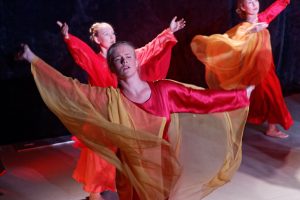
Magaly Müller- Peddinghaus, Eurythmist and Eurythmy teacher at Leiden University introduces the student’s performance on a Rhapsidy by Brahms. In her work with students at the Eurythmy education in Leiden, Magaly Müller- Peddinghaus helps them to develop their instruments in accordance with the requirements needed for the artistic practice of Eurythmy. In the creative process with the students for a recent work developed in dialogue with a composition by Brahms, she asks her students to become conscious of their motifs, of their inspirations. The work is focused on strengthening the expressivity, the lyrical qualities in transitions, to listen to the different layers in the music and to enable the mobility of both doing and watching. The veil which is characteristic to eurythmic costumes is here briefly mentioned as an exoteric aid for the audience to be able to perceive the etheric quality of the movements.
Alexander Seeger speaks about his background with Else Klink in Stuttgart which was in his view rather based on a logic of live transmission and imitation without much explanation. This resulted for him in a sense of not fully understanding what he was actually doing. It was during his encounter with Werner Barfod where he learned to appreciate the practice of writing and analysis and where he started to get acquainted with developing teaching methods. After a period of taking distance from the practice of stage Eurythmy doing other transformative work such as cheese making, he is currently experiencing a re-start, a re-birth, which was initiated by him having to help out at Alanus for a stage Eurythmy performance and recognizing that the work with the individuals, the contact with the people is giving him a reason to continue with this work. Alexander Seeger is interested in more interaction with the audience with Eurythmy, to find other performative formats that bring the performers and audience on a same level. He is interested in small scale creative and collaborative processes and sees there a future direction for Eurythmy. He has experimented with lecture performances and with creating spaces where the audience is included in the performative event. In Alexander’s view and in accordance with a remark by Rudolf Steiner, it is not only 4 the act of looking that opens the aesthetic spectrum of the artist, one also needs to meet the artists themselves, to encounter them in studio visits, to understand what he or she is looking for. With every artist a new way of looking at art and the aesthetic comes to be. The same counts in his view for Eurythmy – every person is developing a new Eurythmy. This is a challenging point of view as it implies a multitude of different possible directions of development, but it also implies a rich variety and diversity of eurythmic expression.
Maartje van der Wees speaks about her first experiences with Ballet and a sense of missing something there of which she did not know what it was. She eventually found it in Eurythmy and describes this “something” as a kind of “streaming” quality. Dancing with words became a life long passion for her, which she experiences as endlessly enriching. Her focus has been mainly on the therapeutic qualities of Eurythmy, harmonizing the physical body with the energetic bodies and thus promoting physical, emotional and spiritual well being. Maartje speaks about Eurythmy as enabling an experience of “something”, a something that lies in between, in the space between. It does not necessarily need to be something mysterious, it is also about the concrete space between people. Through exercising Eurythmy one can develop an eye for this in between space. Words are becoming a form in the space.
Marília Barreto speaks enthusiastically about her having had the privilege of studying with Elisabeth Steglitz at a Waldorf school in Brazil. She has always had an affinity with mathematics and natural science and eventually studied biochemistry and psychology at the university. Having learned to think in a Waldorf school, her experience at the university did not satisfy her need to understand knowledge. The university type of schooling felt to her like devoid of “juice of life” and she realized how much the Waldorf schooling had influenced her. She returned to study Anthroposophy and followed the priest training in Stuttgart. In contradistinction to how she perceived Else Klink’s aesthetic emphasis on form and beauty, she kept seeking the soul and juice of Eurythmy and found a lot of inspiration with Werner Barfod’s teaching style and method. In her teaching as Waldorf high school teacher and with her artistic work at Cia Terra Nova, she is mainly interested in the dialogue between the arts and the sciences. She is fascinated by pursuing to understand the laws that govern both scientific and artistic phenomena and seeks to teach the students a way through laws into freedom. One of her students thinks that doing Eurythmy is better than smoking marihuana, and she herself had many intensive and numinous experiences with doing work on for example the “harmonic eight”, a archetypical Steiner choreography. She is dedicated to promote more research in Eurythmy and also collaborates with a phenomenologist, learning for example to listen to sounds from a phenomenological perspective. She also collaborated with a theatre director and sees these openings towards other disciplines as opportunities to nourish one’s performative instrumentarium. In her experience many people are starving for spirituality and she sees Eurythmy as a way to answer to that need.
Dino Bernardi has been working since many years as a Waldorf school teacher. He began with the study of painting and continued further as a creator of Eurythmy performances, contributing to many elements such as the dramaturgy, the scenography, the costumes etc. He emphasizes the creation of a flow within a performance and also questions how to bring Eurythmy towards the society outside of the Anthroposophical context. In Dino’s view, Eurythmy needs to sacrifice something of itself, to go through a metamorphosis to reach other audiences, and he observes a struggle about how to do this. A Eurythmy performance is for him a whole system, he seeks to create an own language in music and in speech. Artistic creation is for him something very spiritual and deeply connected to Anthroposophy. He is aiming to develop a Eurythmy of all the arts.
Ernst Reepmaker intervenes briefly with his intention to highlight motivs emerging from creative processes – to generate inspirational impulses from within creative processes during this festival.
Suzan Tunca has been working as a dancer, choreographer and choreographic assistant before transforming her dance practice at the University of Amsterdam in the context of an artistic research study. During that study she started to research connections between dance theory and practice and the academic study of Western esotericism. In her studies she encountered various esoteric thinkers and practitioners who developed a movement art in relation to their spiritual practice and philosophy, such as Rudolf Steiner, G.I. Gurdijeff and Rudolf von Laban. She is currently continuing her research at Leiden University investigating the idea of spiritual corporeality in and through dance. She sees dance as naturally spiritual, spirituality as very present during the beginning moments of modern dance and as only implicitly and occasionally present in contemporary dance due to the largely secularized teaching and discursive climate of contemporary dance. Her interest in dance and spirituality has brought her to investigate eurythmy, as it is one of the very few movement art forms that is being practiced world wide and that operates from within an explicitly esoteric and spiritually discursive background.
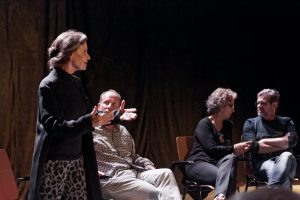
Gail Langstroth speaks about the soulspace that is inherent to the practice of eurythmy. She speaks about clothing herself in the Word every day. Being clothed in the Word allows her to incarnate. Body, thinking and feeling are all living in the Word. She is practicing the art of conversation with a community of female writers which at times gains an orgasmic quality. A major focus in her current work is to generate trust among the African American community in Pittsburgh. She participates in their Gospel Choir. None of these communities has any idea about Eurythmy. During a priest training in Hamburg, she learned to understand more about the mystery of transubstantiation which became for her an affirmation of the roots of Eurythmy. She studied Greek and Hebrew language to understand more about the word roots of our culture. She is asking herself what actually happens when she is experiencing a work of art and has found out that she happens to be moved by it when she meets something in the work of art, when she can meet herself in it. As an example she gives the almond blossom painting by Vincent van Gogh which made her melt, triggered her vulnerability, opened her self, brought her to tears and eventually changed her. She wants this to happen as well when she is teaching or performing. To give the audience the feeling that something in her journey is also in your journey. She aims to create instant communities out of the moment of performing. With her study in priesthood, she understood that it would unite all the talents that she had been given in one. She studied with the Christian Community and their renewed seven sacraments which have been elaborated together with Rudolf Steiner. She finds Steiner’s Christology very universal and is questioning the relation between his Christology and art. She understands religion as a re-connection.
Suzan Tunca asks how they are perceiving the spiritual in the creative processes.
To Gail it has to do with being connected to something that is the connector. For Alexander spirituality is essentially creative. For him a creative process begins with daring not to be connected and then gradually arriving at the connection. How can a space be filled that is filled already? It requires a trust in nothingness, a stepping back to listen, to cut the flow, to receive inspiration and to then arrive at an artistic substance. In the moment of cutting the movement there is an intense activity of listening. Standing in the moment of nothingness is to Alexander an essentially creative act and he associates this with the essence of Christianity. It also has to do with the ability to relax, to sense with the heart and it can certainly be also very sensual, orgasmic.
28.9.19 Elisabeth Vreedehuis
Juliette van Lelieveld: Climate Change + talk with the artist.
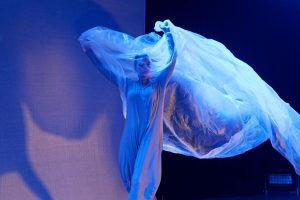
Juliette enters the theatre of the Euritmiezaal with clear messages of humility: she bows before the screen on which there will be projected the planet earth, she bows towards the space, she bows towards the audience. Cellist Larissa Groeneveld enters the space together with her, seating herself and her Cello with the back towards the audience. After a projection of a film about currently known scientific data of the state of the planet and future predictions about her development, Juliette begins her theatrical offering, accompanied by the voice of the Cello in a composition by Jakob ter Veldhuizen. She moves first with very withheld and interiorized movements, silent yet strongly infused with an intentionality the goodwill of which is clearly readable. She then situates herself on a small carriage with wheels, struggling to disentangle herself from ropes that inhibit her freedom of movement, with movements that associate with Pietà qualities. In another sequence she dances with meters of thin plastic foil, giving an aesthetic twist and hint towards the problem of plastic. She ends with a small lamp pointing towards the ground under her feet. The message is clearly not about her, she performs in service of the planet seeking to give her an embodied, theatrical voice.
In the conversation after the performance, an audience member mentions having interpreted Juliette’s performance as a struggle relating to the planet in danger and reminding us of our responsibility towards her and towards future generations. The climate protests in The Hague coincided with Juliette’s performing Climate Change makes the choice of theme obviously relevant and in touch with current societal challenges. Juliette speaks about the soul of the earth, about elements of both “Dolor” and “Gloria” that interweave with her performance. The performative gesture towards the heavens wants to indicate that we are in need of other forces next to our own taking of responsibility to be able to help the planet. Juliette further speaks about the creative process, how first images appeared, which then were tried out and developed further together with her team. To the question about what of the core of Eurythmy is being continued in her performance Juliette answers with “the ensouled movement” (de zielebeweging). According to Juliette it is the same ensouled movement which is usually associated with for example the letters of the alphabet in Eurythmy, but here in dialogue with other materials, with the film, with the plastic, with the ropes. The origin of the movement is the same, it is just another expression of it. Together with director Els Sorber she was seeking to keep feeling this ensouled origin, to find it, and to redefine it. Also Juliette emphasizes the big not knowing as one of the guide lines in a creative process.
WORKSHOP: Dialogue Dance and Eurythmy
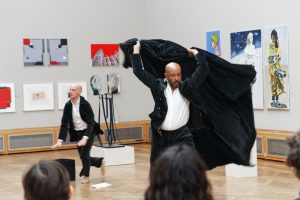
This workshop is led by the Wuppertal based Eurythmist Thomas Feyerabend and dancer Milton Camillo who had performed their duo about friendship Triple Helix in the morning at the Pulchri Studio in dialogue with the art works. The first half of the workshop is led by Thomas, who establishes a sensorial awareness of the body and the space in relation to each other, then moving on to working in couples, mirroring each others movements physically and energetically. Milton takes over the second half of the workshop, leading the participants into a small choreographed sequence which will then be danced along diagonals together with the partner from the first half of the workshop. An atmosphere of friendship comes along as by itself. In the ensuing group conversation, they are being asked about the overlap between their respective approaches to movement, about the connection. They answer that they are trying to find a place or state of mind where they can understand each other. This often happens through the use of images. They began their collaboration with just standing next to each other, questioning the ground they stand on together. Milton emphasizes the need towards mutual generosity, to not work with pressure which may result in the loss of energy. A true work can emerge when there is a sense of collaboration, when both parties are clear with their ideas and when both parties stay open towards each other. They both see a lot of similarity between Eurythmy and Dance. For Milton, Eurythmy is characterized by a lot of quality whereas dancers often don’t know what it is that they are doing. Milton sees eurythmists as intelligent, apt with the use of words. The use of words in dance he sees as being quite rare. Most important is to see the person. In response to a question about the different bodies dancers and eurythmists emphasize in their work – the physical or the etheric/energetic body – Milton answers that dancers often are schooled in Classical Ballet, whereas eurythmists are mostly schooled in the qualities of Eurythmy. Both agree that Eurythmy needs to open herself more towards the outside, to give itself to a world that is sick, a world of which they think that it would want to enjoy it.
Describing their intention of Triple Helix, they state that they see the piece like a crystal in the space, with a lot of space for emptiness, for dance, for eurythmy, for music and the images then may come in the eyes of the onlooker.
Ihoch3 – Workshop + Situatieve Compositie + gesprek
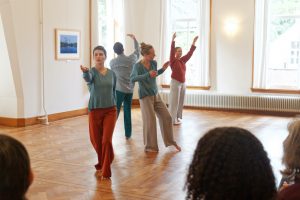
Ihoch3 is a research ensemble focusing on imagination, inspiration and intuition based in Bonn, Germany. The performance by eurythmists Emmanuel Rechenberg, Selma Fricke, Michaela Prader and Jona Lindermayer is centered around Beethoven’s Piano Sonata Appassionata in F Minor, interpreted by pianist Michael Gees.
The audience is prepared to see two different ways of performing the piece, one in which the performers stay within the prescription of the original composition and one where there is explicitly left space for choice making based on the imagination stirred by the composition. In the second version, the four dancers will engage in creating a spontaneous choreography in three movements where the second movement is necessarily different from the first movement, and the third movement is necessarily different from the second movement. The performers will be moving back and forth between the spontaneously emerging potentials.
Striking is the impact of the music as it is being embodied by the four performers simultaneously. Their gaze is open but interiorized, they seem to try to balance a clear awareness about each other in the space in parallel with a sharp synchronization with the music and a deep inner focus on listening and giving an appropriate expression to the music via their movement. Carrying the music in their bodies, they are clearly moving the space. The experience is full and radiant without any need of narrative or décor. In both variations, they manage to actualize a richly alive but abstract realm, moving in, around and beyond the powerful composition of Beethoven, activating both their own and the audience’s inner worlds through their explicit focus on intuitive and inspired choice making.
In the following workshop session, the audience members are invited to experience the performer’s experience through their own bodies in motion accompanied by the pianist. Guided by performer Emmanuel Rechenberg, the audience members populate the space and begin to move in dialogue with their self and with the others while listening deeply to the meaning their movements may want to convey. The audience is invited to take the time to arrive at themselves, to perceive the space and to connect themselves fully with their gestures, while being aware of the collective context. They are being invited to open themselves without leaving themselves or each other.
In the conversation with the artists, they speak about working with different layers, considering the technique of Eurythmy next to other working methods. Each improvisation is a tentative composition responding to what the moment appears to be asking from the performers. Each choice making is connected with steps made in the consciousness of the performer, both in relation to the self as well as in relation to the other. What they are working with can be understood as a kind of “Weltgestaltung” – a creation of worlds, based on imagination, intuition and inspiration. They investigate the relation between sound imagination and movement imagination and work on creating a differentiated and multivocal composition through the inner sound of their moving bodies. The bodies need to be talkative, speaking, and the force field generated by their movements is gaining “Wesenhaftigkeit”, becoming a tangible entity.
KOMPANIE VONNUNAN – shifting reality
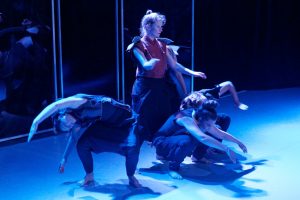
In shifting reality five strong ladies perform a story of two adolescents who immerse themselves in the computergame “Zero”, whereby one of them increasingly shifts her reality into the virtual world of the game. The story of the land of “Zero” introduces a myth of a forgotten land that needs to be reconstituted by a collective effort to regain the missing piece of a puzzle, having to pass through various tests and competitions, which the ladies endeavor to undertake with full dedication. The performance is rich in invention, the performers sing, speak, act and dance and keep the audience engaged through an imaginative and surprising succession of scenes. For a scene situated in a jungle, the audience is asked to create the soundscape by inventing and imitating the sounds of animals. The recording of these sounds then becomes the soundscape of the scene. Concluding message is the invitation to take one’s own destiny into one’s own hands and to be strong enough to embrace the adventure of the here and now. Shifting reality is intended for a young audience but can also speak to the experience of different ages. The performing ladies Anna Lena Häußler, Friederike Heine, Eva Maria Koch, Rosalie Stark and Kirsten Wiebers convince with their performative imagination, self reliance, humor and dedication.
CIA TERRANOVA – In the hollow anatomy of birds
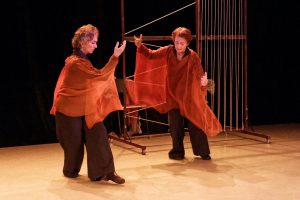
This multi-disciplinary performance by the São Paulo based company introduces an original blend of theatrical modalities, bringing together theatre, music and eurythmy in a poetic essay dedicated to the Brazilian inventor and aviation pioneer Alberto Santos-Dumont. It highlights the creative genius as well as the inner conflicts of the hero of the story – Santos- Dumont – who is vividly embodied and impersonated by actor Viktor Placca. The symbiosis of the musical composition by Marcelo S. Petraglia with the eurythmic choreography performed by Marília Barreto and Renate Nisch – a continuous parallel current to the acting performance by Viktor Placca – is richly elaborated by director Dino Bernardi and performed with high quality and much sensibility towards a poetic logic of language, sound, movement and décor. Even though the speech of the actor Viktor Placca is Portuguese, it is possible to accompany the performers in their investigative journey into the soul of Santos-Dumont. Only occasionally is the Portuguese language translated into English, leaving the audience nevertheless with an inspired hommage to a man of high creative genius who struggled intensely with losing control over his uninhibited inventory drift in its application in society. “Only men with broad thinking will decode these echoes” keeps resonating several times through the theatrical space towards the end of the piece, leaving the audience with an invitation to actively broaden their minds and giving evidence of the dedicated group effort to provide continuity for the spirit of Santos – Dumont through artistic and scientific invention and research.
GAIL LANGSTROTH – Firegarden / Jardin de Fuego
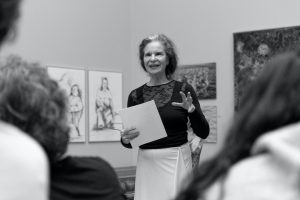
This performance is based on a bilingual book containing Spanish and English versions of Gail Langstroth’s lyrical poetry. It begins with a video work featuring Gail in a red gown standing in the center of a gate and with a visual play with the inversion of the letters ROT – TOR. When Gail appears in person on stage, she performs 12 of her poems in English and in Spanish, tasting, spitting, yelling and moulding the words with every fiber of the totality of her being. Gail appears as a master of the embodied word. There is a sense of fullness of being with this performer, radiating a great spiritual strength and life wisdom. Strongly remaining impressions are the accounts of having distributed the ashes of her loved ones, of bones that do not burn, of spirit suggesting another logic and of a lifelong quest for the meaning of the relation between spirit and the flesh of the human body. Life is a passing through gates, both in entry and exit, this message accompanied by the enduring sound of church bells in a small Spanish village brings closure to this Saturday evening, saturating it with depth of meaning.
29.10. 2019 Pulchri Studio
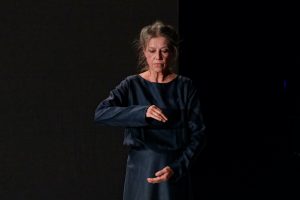
Birgit Hering opens this morning at the Pulchri Studio with Vensterbeeld, an improvised sequence inspired by a poem by Paul Celan. Ellen engages the audience in a light interactive game where she invites them to close and open their eyes when given specific sound cues by her. She displaces herself in the space and in relation to different artworks during the moments when the audience is not directing their gaze towards her. Each time the eyes open, she is in a different place, in a different relation with the space. Her movements are lively and sparkling, the scope of interpretation that is left to the onlooker is wide.
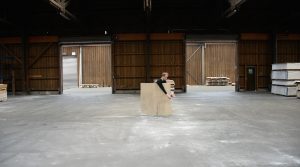
Hans Wagenmann enters the space with a big piece of cardboard. In how he enters the space some kind of resonance with Joseph Beuys seems to enter with him. The audience knows that Hans will perform an extract from his “Heimaten” cycle. Hans treats the piece of cardboard, his movement and the space with clear yet seemingly not fully pre- defined intentionality, as if he invites the onlooker to fill his rather abstract etude on body, movement, space and cardboard with personal narratives and imaginations. I begin to associate the cardboard with being the “Heimat” of homeless people and remember a homeless man whom I had observed on the way from The Hague CS to Pulchri. It was raining heavily and a strong wind made it almost impossible for him to safe his belongings from becoming completely drowned by trying to cover them up under a too small piece of plastic, seeking refugee under an old tree. I continued with this association in my mind as a parallel track to observing Hans perform with the cardboard and the space, making a spontaneous decision to contribute in one way or the other to helping homeless people find a roof and a bed if the opportunity will arise. One simple but decisive movement of Hans made the cardboard fall – making visible an unexpected cause and effect relation on a distance between the body of Hans and the cardboard that was balancing in the space like a wall questioning its purpose. Hans’ movements appear to be carefully thought through in relation to a sense of spatial geometry, in relation to abstract ideas or laws that bend the space and unfold various perspectives. Knowing that Hans engages his art also in relation to social questions, it is interesting to observe that his performances activated a social sense in my inner world. This might be a consequence of knowing about his social artistic engagement in combination with the open space of felt abstraction that Hans constructed in the space.
Gia van den Akker performs a poem of Giuseppe Ungaretti (Fase d’Orient, Versa il 27. Aprile 1916) and dedicates it to her mother in law who had recently passed away. With humility, delicacy, care and poetic precision, Gia performs this poem with solemn dedication. There is beauty, grace and serene inwardness. She engages in an intimate whispering dialogue with the NOW artwork, as if speaking to an invisible but old friend, as if she asks it to take care of something, forever. Some fragments of the poem remain in the conscious memory and the audience is given the printed version of it, to be able to re-read it: “… Ci vendemmia il sole … De zon oogst ons …Ci rinveniamo a marcare la terra con questo corpo che ora troppo ci pesa … We komen weer terug om de aarde te merken, met dit lichaam, dat nu te zwaar is voor ons …” In her movements, Gia seems to retain something, something like an inner fire which she orients and transforms towards a ritual of commemoration and blessing through writing her movements into the space.
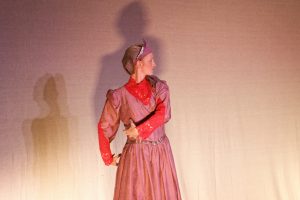
Ellen Freijser performs a eurythmic interpretation of La Poesía by Pablo Neruda in relation to an artwork that depicts a colorful view on a street in a city. La Poesía (Poëzie) aims to capture in poetic form what being a poet implies. Ellen performs her eurythmic interpretation in dialogue with pianist Alicia Witarsa (playing Gubaidolina) and speaker Geesiena Stradmeijer. It is clear from the clarity and schooling of articulation of Ellen’s entire body, that she has been trained in both dance and Eurythmy. Her performative presence is light, aerial and imaginative. A talented young performer that radiates a promise of future contribution to the further evolution of Eurythmy.
Postscript
In a brief conversation with Juliette van Lelieveld, we agree that Dance and Eurythmy are not so far from each other as it might seem considering the historical divide that had separated the respective evolutions of Eurythmy and Dance as distinct art forms operating in distinct domains of art and society. Considering the discursive backdrop with which both movement art forms operate, it is clear that Eurythmy explicitly engages with terms such as “the soul”, “the spiritual” and the “esoteric” whereas comparable phenomena and points of attention in contemporary dance are maybe rather dealt with from experiential, aesthetic and artistically qualitative points of view, clothed in secularized terminology such as consciousness, awareness, perception, physicality, affect, energy etc. There is no explicit reference to spirituality in most contemporary dance practice (although it does seem to come more to the surface in recent years). If a specific quality of motion that may resonate with “soul” and “spirit” qualities is present in dance, it is mostly implicit in the dance, not explicit on a verbal level. In both – Eurythmy and Dance – a good question to ask might be “when is it real?” When is a cerebral conceptualization of an ensouled quality within a movement art fully tangible in the embodied performance and reception of the performance and when not, and why? Aren’t what might be called spiritual aspects of a creative process (such as having the faith and trust to enter the unknown, surrendering to a bigger connecting force or to an ideal and intense listening to what the artistic creation needs to become) in essence transcultural, transaesthetic and transreligious phenomea or something like inner laws of artistic creation?
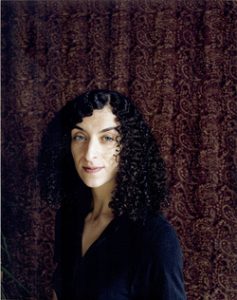 Suzan Tunca
Suzan Tunca
*1975 studied theatre dance at the highschool for the arts in Arnhem. Since 1998 she has worked as a dancer, choreographer and choreographic assistant in the Netherlands and internationally. Until 2005 she collaborated among others with Krisztina de Châtel and Dylan Newcomb. With her solo works, she invested in a long term dialogue between the dancing body and the development of interactive music technology transcribing motion into sound. Between 2005-2013 she danced with Emio Greco | PC. In 2007 she was nominated for the “swan most impressive dance performance” in the Netherlands. 2015 she completed a research MA artistic research at the University of Amsterdam with the video work and live performance “The Logic of the Dancing Body” and a written thesis “Esoteric Dimensions in the Logic of the Dancing Body.” She is currently researching dance at ICK Amsterdam under the thematic umbrella of dance documentation, notation and knowledge transfer, teaching and coaching dance and choreography students in artistic research at Codarts University of the Arts and at the MA choreography COMMA and is a PhD candidate at PhDArts Leiden University.
